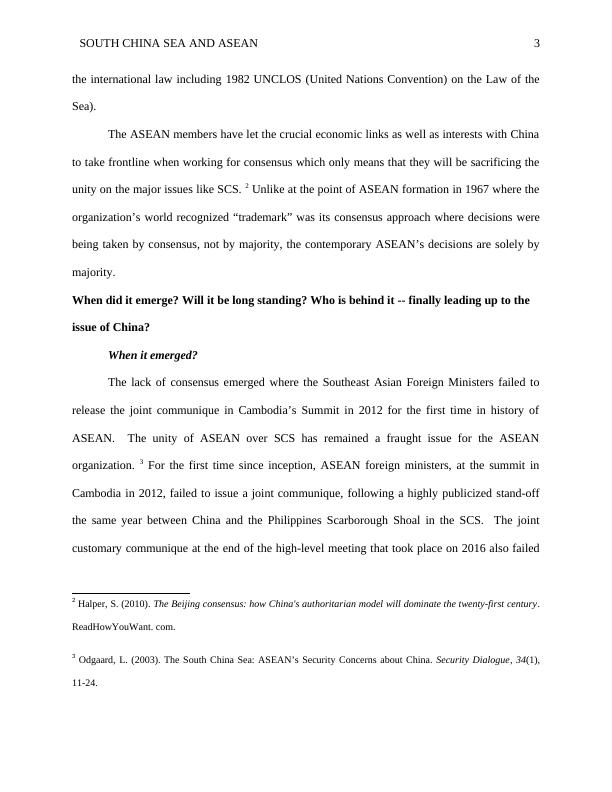South China Sea and ASEAN Assignment
12 Pages3440 Words106 Views
Added on 2020-03-16
South China Sea and ASEAN Assignment
Added on 2020-03-16
ShareRelated Documents
Running head: SOUTH CHINA SEA AND ASEAN 1South China Sea and ASEANNameInstitution

SOUTH CHINA SEA AND ASEAN 2There is a lack of consensus in ASEAN? Why? The major reason for the absence of ASEAN’s consensus is due to the activities of Chinaon the South China Sea (SCS). The ASEAN defense ministers were thus enable to agree on thejoint statement after the meeting/forum held on Wednesday. This inability is a clear reflection ofthe concern of these ministers about the activity of China in the South China Sea. This remaineda salient issues of discussion as well as one of great concern by nations in the meeting since itwas raised by everyone. For example, it was apparent from the unanimous decision by the PACin 2016 that China’s activities were hurting Philippines. The Court ruled in favor of Philippines in most questions including that Chinese shipsbehavior were physically obstructing the vessels of Philippines and against the law. The Tribunalfurther awarded that the nine-dash line of China alongside the claim to historic rights in SCSwere both invalid as per the international law. 1 The Meeting held in 2016 showed lack ofconsensus where defense Ministers had to retract their statement that recognized the activities inSCS. They had expressed their serious concern over the latest and ongoing development that haderoded trust as well as confidence, augmented tensions as well as which could have the potentialof undermining peace, security as well as stability in the SCS. The retracted statement had also recognized and emphasized the significance of non-militarization as well as self-restraint in conduct of each activity, including land reclamation thatcould raise tensions in SCS. They further retracted the statement where they had emphasized thesignificance of maintaining peace, stability, security, safety as well as freedom of navigation inalongside overflight above the SCS according to the conventionally acknowledged principles of1Ba, A. D. (2003). China and ASEAN: renavigating relations for a 21st-century Asia. Asian Survey, 43(4), 622-647.

SOUTH CHINA SEA AND ASEAN 3the international law including 1982 UNCLOS (United Nations Convention) on the Law of theSea). The ASEAN members have let the crucial economic links as well as interests with Chinato take frontline when working for consensus which only means that they will be sacrificing theunity on the major issues like SCS. 2 Unlike at the point of ASEAN formation in 1967 where theorganization’s world recognized “trademark” was its consensus approach where decisions werebeing taken by consensus, not by majority, the contemporary ASEAN’s decisions are solely bymajority. When did it emerge? Will it be long standing? Who is behind it -- finally leading up to the issue of China? When it emerged?The lack of consensus emerged where the Southeast Asian Foreign Ministers failed torelease the joint communique in Cambodia’s Summit in 2012 for the first time in history ofASEAN. The unity of ASEAN over SCS has remained a fraught issue for the ASEANorganization. 3 For the first time since inception, ASEAN foreign ministers, at the summit inCambodia in 2012, failed to issue a joint communique, following a highly publicized stand-offthe same year between China and the Philippines Scarborough Shoal in the SCS. The jointcustomary communique at the end of the high-level meeting that took place on 2016 also failed2Halper, S. (2010). The Beijing consensus: how China's authoritarian model will dominate the twenty-first century.ReadHowYouWant. com.3Odgaard, L. (2003). The South China Sea: ASEAN’s Security Concerns about China. Security Dialogue, 34(1),11-24.

SOUTH CHINA SEA AND ASEAN 4to happen in August as the statement was retracted barely hours after it had been releasedfollowing the mention of Chinese illegal activities in the SCS. Will it be long standing? This lack of consensus will really be a long standing issue following the activities ofChina in the SCS. In absence of a leadership initiative on the part an ASEAN’s more neutralstates makes it increasingly doubtful that ASEAN policy toward China shall change any soon.This is because ASEAN members seem to have the potential to lead the organization that can byextension establish a consensus on China. 4 Such a regional leader seems not to be here yet sinceit will need capacity both human and financial resources, internal commitment to undertake aleadership role as well as the buy-in of its regional as well as global neighbor. None of theASEAN members seems to fit this decision yet or even come close to fitting it. For example,Jakarta stays the symbolic head that host the secretariat of ASEAN, yet Indonesia presently lacksthe will to take the definitive leadership responsibility and role. The future of ASEAN will remain tied to rise of China. With an array of economic,military and political variances among ASEAN members, ASEAN requires a string voice amongthe member countries to guide both external and internal consultation, were members hope togenerate on ASEAN-centric approach to issues of security and ultimate creation of consensus. Inabsence of a committed as well as capable ASEAN leader (s) on political-security matters,periodic eruptions of crises in SCS might continue to turn the status quo balance of power intothe ASEAN chronic instability. Who is behind it -- finally leading up to the issue of China? 4Buszynski, L., & Sazlan, I. (2007). Maritime claims and energy cooperation in the South China Sea.Contemporary Southeast Asia: A Journal of International and Strategic Affairs, 29(1), 143-171.

End of preview
Want to access all the pages? Upload your documents or become a member.
